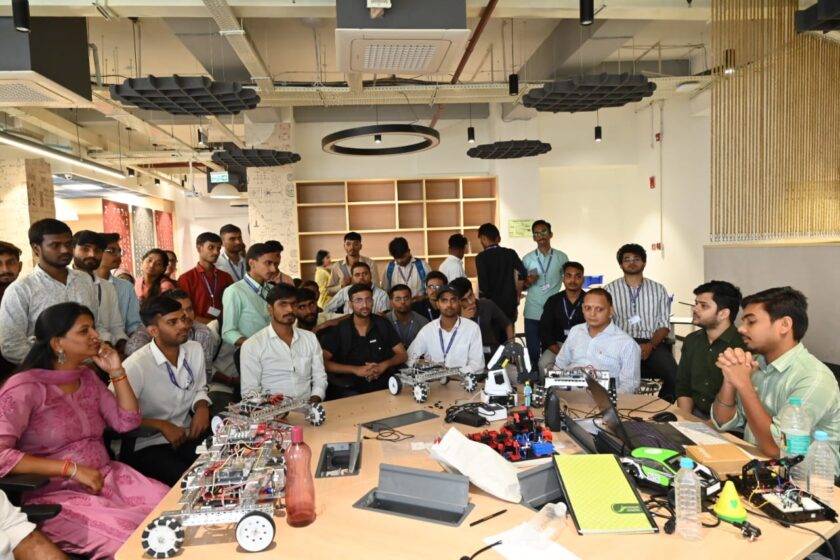Lucknow – The use of technology on the battlefield has undergone a dramatic transformation, reshaping military strategies and redefining the nature of conflict. From the integration of artificial intelligence (AI) to the proliferation of drones and cyber warfare, modern battlefields are increasingly digital, interconnected, and autonomous, with significant implications for both military effectiveness and ethical considerations. The evolution of battlefield technology traces back to ancient innovations like the chariot around 400 BCE, which provided speed and mobility, as noted in historical analyses of military technology. By the 19th century, the Industrial Revolution introduced mass production, enabling rapid-fire weapons like the Gatling gun and steel warships, which revolutionized logistics and firepower. The 20th century saw further leaps with tanks, aircraft, and nuclear weapons, particularly during World Wars I and II, where radar and the Enigma machine transformed intelligence and strategy.
In recent decades, the pace of technological advancement has accelerated. The Gulf War in the 1990s demonstrated the power of precision-guided munitions and real-time battlefield intelligence, with sensors like radar and infrared providing a clearer picture of the battlefield. Today, the focus has shifted to digital and autonomous systems, driven by the need for greater efficiency, reduced casualties, and the ability to counter asymmetric threats like terrorism and insurgency.
Current Trends in Battlefield Technology
Drones and Unmanned Systems
Drones have become a cornerstone of modern warfare, used for surveillance, reconnaissance, and targeted strikes. The US Army’s “Transforming in Contact” initiative, as highlighted in recent posts on X, emphasizes counter-unmanned aerial systems and electronic warfare, reflecting the growing reliance on drones. For instance, Shield AI’s V-BAT drones, with a 300-mile range and resistance to electronic interference, have enhanced capabilities in conflicts like Ukraine. However, the proliferation of small, cheap drones has made traditional air defense systems economically impractical, as noted by Ukrainian General Valerii Zaluzhnyi in a recent statement.
Artificial Intelligence and Autonomy
AI is revolutionizing battlefield decision-making by analyzing vast amounts of data in real-time to identify patterns and predict enemy movements. The Air Combat Evolution (ACE) program by DARPA, initiated in 2019, uses AI for human-machine collaborative dogfighting, allowing pilots to act as mission commanders while managing unmanned “loyal wingmen” drones. Autonomous weapons systems, such as those seen in the Libyan War in 2021, operate with minimal human intervention, raising ethical concerns about accountability and the potential for misuse by non-state actors.
Cyber and Electronic Warfare
Cyber warfare has opened a new front, where a single attack can disrupt communication networks and critical infrastructure. The US military’s focus on cybersecurity, as discussed in recent analyses, underscores its importance in modern operations. Electronic warfare, including jamming and signal disruption, is also critical, with systems like the US Army’s Small Multipurpose Equipment Transport (SMET) and Ghost Robotic Dog enhancing human-machine integration on the battlefield.

Network-Centric Warfare
The concept of a unified battlefield, supported by real-time data sharing across land, air, and sea, is becoming a reality. The F-35 fighter jet, with over 8 million lines of code, exemplifies the “softwarization” of combat, integrating sensors, tactical decision aids, and secure communications via satellites and laser systems. Posts on X suggest that network-centric warfare could soon enable soldiers to use iPad-like devices to track enemy movements via satellite, drone, and human intelligence, a development that appears imminent.
Techcraft and Soldier Skills
The US Army’s concept of “techcraft,” introduced by Army Futures Command, highlights the need for soldiers to master new skills in a technology-infused battlefield. Units like the 3rd Battalion, 4th Cavalry Regiment, are incorporating drones into daily training, such as drone-enhanced physical readiness exercises, to familiarize soldiers with autonomous systems.
Implications and Challenges
The shift toward technology-driven warfare offers significant advantages, such as increased precision, reduced collateral damage, and enhanced soldier safety. Drones and AI enable strikes with pinpoint accuracy, while network-centric systems improve coordination and situational awareness. However, these advancements come with challenges. The high cost of modern weaponry—exemplified by the $4.6 trillion US intervention in Iraq compared to $3.6 trillion for World War II (adjusted for inflation)—strains budgets, pushing militaries to do more with less. The rise of autonomous systems also raises ethical questions, particularly around the lack of human oversight in lethal decision-making, as seen in debates over lethal autonomous weapons (LAWs).
Moreover, the evolving battlefield favors adaptability over raw technological superiority. Historical examples, like the Yom Kippur War of 1973, show that technology alone doesn’t guarantee victory—Israel recovered from a surprise attack not through superior tech but through strategic adaptation. Similarly, in modern conflicts like Iraq and Afghanistan, advanced technology has not always translated into strategic success without a clear political purpose.
The Future of Battlefield Technology
Looking ahead, the battlefield is likely to become even more autonomous and digital. Seventh-generation warfare, potentially emerging later this century, could see fully automated systems driven by AI, nanotechnology, and robotics, removing human decision-making entirely—a prospect that remains controversial. Space technology, already integral for reconnaissance and communication, may expand into weapon systems, while cyber warfare will continue to grow as a primary domain of conflict. In regions like Uttar Pradesh, where agri-tech innovations like drones for crop monitoring are gaining traction, there’s potential for dual-use technologies to influence military applications. The state’s adoption of AgriVoltaic farming and high-tech nurseries could inspire sustainable energy solutions and controlled environments for military bases, enhancing logistical resilience.
The evolution of technology on the battlefield reflects a broader trend of increasing complexity and interconnectedness in warfare. While drones, AI, and cyber capabilities offer unprecedented advantages, they also demand new strategies, ethical frameworks, and skills. As General Randy George of the US Army noted in a 2024 interview, “Transforming in contact allows us to adapt quickly to technological surprises.” The future of warfare will hinge not just on technology, but on the ability to integrate it with strategy, adaptability, and a clear understanding of the human element in conflict.






